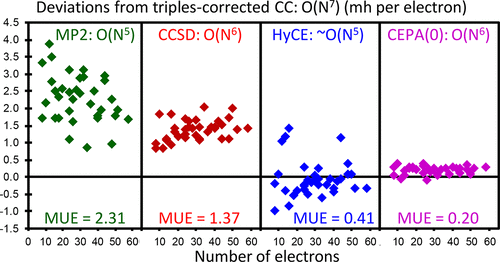当前位置:
X-MOL 学术
›
J. Phys. Chem. A
›
论文详情
Our official English website, www.x-mol.net, welcomes your
feedback! (Note: you will need to create a separate account there.)
Hybrid Correlation Energy (HyCE): An Approach Based on Separate Evaluations of Internal and External Components
The Journal of Physical Chemistry A ( IF 2.7 ) Pub Date : 2018-05-23 00:00:00 , DOI: 10.1021/acs.jpca.8b01794 Joseph Ivanic 1 , Michael W. Schmidt 2
The Journal of Physical Chemistry A ( IF 2.7 ) Pub Date : 2018-05-23 00:00:00 , DOI: 10.1021/acs.jpca.8b01794 Joseph Ivanic 1 , Michael W. Schmidt 2
Affiliation

|
A novel hybrid correlation energy (HyCE) approach is proposed that determines the total correlation energy via distinct computation of its internal and external components. This approach evolved from two related studies. First, rigorous assessment of the accuracies and size extensivities of a number of electron correlation methods, that include perturbation theory (PT2), coupled-cluster (CC), configuration interaction (CI), and coupled electron pair approximation (CEPA), shows that the CEPA(0) variant of the latter and triples-corrected CC methods consistently perform very similarly. These findings were obtained by comparison to near full CI results for four small molecules and by charting recovered correlation energies for six steadily growing chain systems. Second, by generating valence virtual orbitals (VVOs) and utilizing the CEPA(0) method, we were able to partition total correlation energies into internal (or nondynamic) and external (or dynamic) parts for the aforementioned six chain systems and a benchmark test bed of 36 molecules. When using triple-ζ basis sets it was found that per orbital internal correlation energies were appreciably larger than per orbital external energies and that the former showed far more chemical variation than the latter. Additionally, accumulations of external correlation energies were seen to proceed smoothly, and somewhat linearly, as the virtual space is gradually increased. Combination of these two studies led to development of the HyCE approach, whereby the internal and external correlation energies are determined separately by CEPA(0)/VVO and PT2/external calculations, respectively. When applied to the six chain systems and the 36-molecule benchmark test set it was found that HyCE energies followed closely those of triples-corrected CC and CEPA(0) while easily outperforming MP2 and CCSD. The success of the HyCE approach is more notable when considering that its cost is only slightly more than MP2 and significantly cheaper than the CC approaches.
中文翻译:

混合相关能量(HyCE):一种基于内部和外部组件独立评估的方法
提出了一种新颖的混合相关能量(HyCE)方法,该方法通过对其内部和外部成分的不同计算来确定总相关能量。这种方法是从两项相关研究演变而来的。首先,对包括扰动理论(PT2),耦合簇(CC),构型相互作用(CI)和耦合电子对近似(CEPA)在内的许多电子相关方法的精度和尺寸扩展性进行了严格的评估,结果表明:后者的CEPA(0)变体和三重校正的CC方法始终具有非常相似的性能。这些发现是通过与四个小分子的接近全CI结果进行比较,并通过绘制六个稳定增长的链系统的回收相关能来绘制的。其次,通过生成价虚拟轨道(VVO)并利用CEPA(0)方法,我们能够将上述六个链系统和一个由36个分子组成的基准测试床的总相关能量划分为内部(或非动态)和外部(或动态)部分。当使用三重ζ基集时,发现每个轨道的内部相关能量明显大于每个轨道的外部能量,并且前者的化学变化远大于后者。此外,随着虚拟空间的逐渐增加,外部相关能量的积累可以平稳地进行,并且呈线性关系。这两项研究的结合导致了HyCE方法的发展,其中内部和外部相关能量分别通过CEPA(0)/ VVO和PT2 /外部计算分别确定。当应用于六链系统和36分子基准测试装置时,发现HyCE能量紧随三重校正CC和CEPA(0)的能量,同时轻松胜过MP2和CCSD。考虑到HyCE方法的成本仅比MP2略高一点,并且比CC方法便宜得多,因此其成功之处更为显着。
更新日期:2018-05-23
中文翻译:

混合相关能量(HyCE):一种基于内部和外部组件独立评估的方法
提出了一种新颖的混合相关能量(HyCE)方法,该方法通过对其内部和外部成分的不同计算来确定总相关能量。这种方法是从两项相关研究演变而来的。首先,对包括扰动理论(PT2),耦合簇(CC),构型相互作用(CI)和耦合电子对近似(CEPA)在内的许多电子相关方法的精度和尺寸扩展性进行了严格的评估,结果表明:后者的CEPA(0)变体和三重校正的CC方法始终具有非常相似的性能。这些发现是通过与四个小分子的接近全CI结果进行比较,并通过绘制六个稳定增长的链系统的回收相关能来绘制的。其次,通过生成价虚拟轨道(VVO)并利用CEPA(0)方法,我们能够将上述六个链系统和一个由36个分子组成的基准测试床的总相关能量划分为内部(或非动态)和外部(或动态)部分。当使用三重ζ基集时,发现每个轨道的内部相关能量明显大于每个轨道的外部能量,并且前者的化学变化远大于后者。此外,随着虚拟空间的逐渐增加,外部相关能量的积累可以平稳地进行,并且呈线性关系。这两项研究的结合导致了HyCE方法的发展,其中内部和外部相关能量分别通过CEPA(0)/ VVO和PT2 /外部计算分别确定。当应用于六链系统和36分子基准测试装置时,发现HyCE能量紧随三重校正CC和CEPA(0)的能量,同时轻松胜过MP2和CCSD。考虑到HyCE方法的成本仅比MP2略高一点,并且比CC方法便宜得多,因此其成功之处更为显着。











































 京公网安备 11010802027423号
京公网安备 11010802027423号